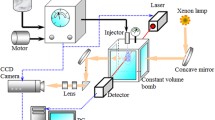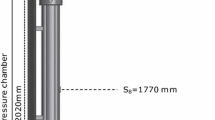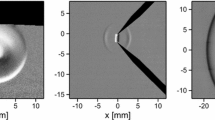Abstract
An experimental study of the interaction of a shock wave with a hexane droplet is presented. The main goal of the experiments was to record images of the process and measure basic parameters describing movement, dispersion and evaporation of the droplets engulfed by a shock wave propagating in air. A shock tube with a visualization section was used for this research. Photography of the process allowed one to measure the positions, velocities and sizes of mist clouds created by the interaction processes. Analysis of the pictures shows that there is no qualitative difference between cases for different size droplets, but shock Mach number had a significant effect on the process. Quantitative analysis shows that under certain conditions, a catastrophic breakup mechanism of dispersion occurred. The droplets are shattered into a mist cloud before they achieve mechanical equilibrium with the surrounding gas. The approximate time for the complete dispersion and acceleration of the fuel droplet varies from 300 to 500 μs, and depends both on the droplet diameter and shock velocity. The dispersion time is controlled principally by the droplet diameter, and to a lesser extent, the shock Mach number.
Similar content being viewed by others
References
Gelfand B.E.: Droplet breakup phenomena in flows with velocity lag. Prog. Energy Combust. Sci. 22(3), 201–265 (1996). doi:10.1016/S0360-1285(96)00005-6
Vieille, B., Chauveau, C., Gokalp, I.: Droplet Breakup Regimes Under High Pressure Conditions. AIAA Paper. AIAA-98-0715 (1998)
Dinh, T.N., Li, G.J., Theofanous, T.G.: An Investigation of Droplet Breakup in a High Mach, Low Weber Number Regime. AIAA Paper. AIAA 2003-317 (2003)
Li, G.J., Dinh, T.N., Theofanous, T.G.: An experimental study of droplet breakup in supersonic flow: The Effect of Long-Range Interactions. In: 42nd AIAA Aerospace Sciences Meeting and Exhibit, Reno, Nevada (2004)
Fox, G.E., Dabora, E.K.: Breakup of liquid drops due to convective flow in shocked sprays. In: 14th Symposium (International) on Combustion, The Combustion Institute, University Park, Pensylvania (1972)
Bar-Or, R., Sichel, M., Nicholls, J.A.: The propagation of cylindrical detonations in monodisperse sprays. In: 18th Symposium (International) on Combustion, The Combustion Institute, Waterloo, Canada (1981)
Bar-Or, R., Sichel, M., Nicholls, J.A.: The reaction zone structure of cylindrical detonations in monodisperse sprays. In: 19th Symposium (International) on Combustion, The Combustion Institute, Haifa, Israel (1982)
Gieras M. et al.: Influence of the chamber volume on the upper explosion limit for hexane-air mixtures. J. Loss Prev. Process Ind. 21, 423–436 (2008). doi:10.1016/j.jlp.2008.02.006
Gieras, M., et al.: Evaluation of rich explosion/detonation limits for hexane-air mixtures. Final Report US-Polish Cooperative Science and Technology Program. Institute of Heat Engineering, Warsaw University of Technology (2003)
Gordon, S., McBride, B.J.: Computer Program for Calculation of Complex Chemical Equilibrium Composition and Aplication I. Analysis. NASA (NASA RP-1311) (1976)
Aggarwal S.K.: A review of spray ignition phenomena: present status and future research. Prog. Energy Combust. Sci. 24(6), 565–600 (1998). doi:10.1016/S0360-1285(98)00016-1
Miyasaka, K., Mizutani, Y.: Ignition delays of spray columns behind a reflected shock. In: Sixteenth Symposium (International) on Combustion (1977)
Zhukov V.P., Sechenov V.A., Starikovskii A.Y.: Ignition delay times in lean n-hexane-air mixture at high pressures. Combust. Flame 136(1–2), 257–259 (2004). doi:10.1016/j.combustflame.2003.10.002
Hawthorn R.D., Nixon A.C.: Shock tube ignition delay studies of endothermic fuels. AIAA J. 4(2), 513–520 (1966)
Ranger A.A., Nicholls J.A.: Aerodynamic shattering of liquid drops. AIAA J. 7(2), 285–290 (1969)
Crowe C., Sommerfeld M., Tsuji Y.: Multiphase Flows with Droplets and Particles. CRC Press, Boca Raton (1998)
Chang E.J., Kailasanath K.: Shock wave interactions with particles and liquid fuel droplets. Shock Waves 12, 333–341 (2003). doi:10.1007/s00193-002-0170-1
Kolev N.I.: Multiphase Flow Dynamics, vol. 2, 2 edn. Springer, Berlin (2005)
Hsiang L.-P., Faeth G.M.: Drop deformation and breakup due to shock wave and steady disturbance. Int. J. Multiph. Flow 21(4), 545–560 (1995). doi:10.1016/0301-9322(94)00095-2
Schmehl, R., et al.: Efficient numerical calculation of evaporating sprays in combustion chamber flows. In: Gas Turbine Engine Combustion, Emissions And Alternative Fuels, Lisbon (1998)
Author information
Authors and Affiliations
Corresponding author
Additional information
Communicated by S. Dorofeev.
This paper is based on work that was presented at the 20th International Colloquium on the Dynamics of Explosions and Reactive Systems, Montreal, Canada, July 31–August 5, 2005.
Rights and permissions
About this article
Cite this article
Kobiera, A., Szymczyk, J., Wolański, P. et al. Study of the shock-induced acceleration of hexane droplets. Shock Waves 18, 475–485 (2009). https://doi.org/10.1007/s00193-008-0184-4
Received:
Revised:
Accepted:
Published:
Issue Date:
DOI: https://doi.org/10.1007/s00193-008-0184-4




